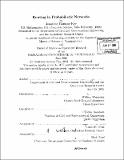| dc.contributor.advisor | William Weinstein and Cynthia Barnhart. | en_US |
| dc.contributor.author | Key, Jonathan Ramsay, 1976- | en_US |
| dc.contributor.other | Massachusetts Institute of Technology. Operations Research Center. | en_US |
| dc.date.accessioned | 2005-10-14T20:15:57Z | |
| dc.date.available | 2005-10-14T20:15:57Z | |
| dc.date.copyright | 2004 | en_US |
| dc.date.issued | 2004 | en_US |
| dc.identifier.uri | http://hdl.handle.net/1721.1/29387 | |
| dc.description | Thesis (S.M.)--Massachusetts Institute of Technology, Dept. of Civil and Environmental Engineering; and, (S.M.)--Massachusetts Institute of Technology, Operations Research Center, 2004. | en_US |
| dc.description | Includes bibliographical references (p. 143-146). | en_US |
| dc.description.abstract | This thesis considers tlhe problem of routing in a network where the travel times along the arcs are modeled as independent random variables. A standard approach to routing in such networks is to select a path with the least expected travel time. One of the problems with this approach is that it does not take into consideration factors such as the travel time variance. Additionally. such an approach implicitly assumes each user in the network has the same routing objective. In this thesis we develop an approach to routing in probabilistic networks in which these problems are addressed. The fundamental concept in our approach is that, for a given user with a set of routing options at a given node. we approximate the distributions of travel time for these options. Using these approximate distributions, the options are compared according to a user-specified routing objective, and the best option is selected. The primary benefit of this approach is that one is not limited to a particular routing objective as the computed distributions of travel time allow us to efficiently determine an effective routing option for a arbitrary routing objective that depends on factors of random travel time other than the mean. The distribution of travel time adopted in this thesis is the minimum travel time probability distribution. which is the distribution of travel time over all fastest paths. In a class of networks termed as series-parallel networks. the minimum travel time distribution can be calculated efficiently. | en_US |
| dc.description.abstract | (cont.) For general, non-series-parallel networks. the approximation we adopt is the minimum travel time distribution obtained from a related series-parallel network. The performance and the benefits of this approach to routing are illustrated on three networks. The numerical results are obtained using an efficient implementation of the algorithms proposed in this thesis. We also consider the problem of generating an acyclic graph from a cyclic graph, and we propose a data structure that allows for the efficient calculation of the sum and minimum of independent random variables. | en_US |
| dc.description.statementofresponsibility | by Jonathan Ramsay Key. | en_US |
| dc.format.extent | 146 p. | en_US |
| dc.format.extent | 5932340 bytes | |
| dc.format.extent | 5932149 bytes | |
| dc.format.mimetype | application/pdf | |
| dc.format.mimetype | application/pdf | |
| dc.language.iso | eng | en_US |
| dc.publisher | Massachusetts Institute of Technology | en_US |
| dc.rights | M.I.T. theses are protected by copyright. They may be viewed from this source for any purpose, but reproduction or distribution in any format is prohibited without written permission. See provided URL for inquiries about permission. | en_US |
| dc.rights.uri | http://dspace.mit.edu/handle/1721.1/7582 | |
| dc.subject | Civil and Environmental Engineering. | en_US |
| dc.subject | Operations Research Center. | en_US |
| dc.title | Routing in probabilistic networks | en_US |
| dc.type | Thesis | en_US |
| dc.description.degree | S.M. | en_US |
| dc.contributor.department | Massachusetts Institute of Technology. Department of Civil and Environmental Engineering | |
| dc.contributor.department | Massachusetts Institute of Technology. Operations Research Center | |
| dc.identifier.oclc | 56125179 | en_US |

